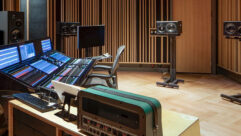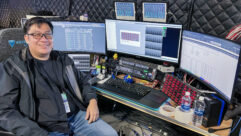
Installation Profile:
Delaware’s Legislative Hall
May 1, 2005 12:00 PM,
By Daniel Keller
The First State once again sets the agenda for the future.
Delaware’s legislators meet in the refurbished rooms of the Georgian-style Legislative Hall in the state’s capitol, Dover.
As the nation’s oldest state, Delaware has always held a somewhat unique status here in the United States. It’s not a big place — roughly two hours from end to end; only Rhode Island covers less acreage — and is sometimes overshadowed by its high-profile metropolitan neighbors in Maryland, Pennsylvania, New Jersey, and Washington, D.C. But, as the first state to officially ratify the U.S. Constitution, Delaware is a place awash in history and precedent. It is largely credited with establishing the country’s first congress, creating the two-house legislative model, which was subsequently adapted by the rest of the union and the federal government. From the seating arrangements to protocol and procedure, Delaware’s founding fathers essentially set the stage for the way our government works today.
Delaware’s legislators meet in capitol city Dover’s celebrated Legislative Hall, a majestic Georgian-styled colonial building of handmade brick, designed by the architect E. William Martin. The structure was dedicated in 1933, replacing the original 18th century State House, which is located across the city’s historic Civic Green mall (and today hosts the capitol’s museum and historical society). The main Legislative Hall, housing the chambers of the House and Senate, was expanded during the first half of the 1990s, with the addition of north and south wings built to provide offices for each legislator. But the historical integrity of the building and its hallowed halls has been well maintained; its high ceilings and stoic walls unchanged over the years.
Among other aspects unchanged for far too long were the halls’ audio systems. “The equipment we took out wasn’t tin cans and string, but it was pretty close,” quips Nathan Powell, the design consultant behind the hall’s revamped sound system. “Clamped to each desk were 1960s-vintage dynamic mics on 20in. goosenecks that creaked when you moved them, which the delegates regularly do — sending a delightful noise over the house PA.”
Powell, who now heads his own company, Production Technical Consultants (PTC) Group, was principal audio systems consultant with Philadelphia-based Metropolitan Acoustics, the design firm behind such projects as Montreal’s Cirque du Soleil and New York’s Roxy nightclub.
The original system was somewhat archaic and ineffective, to be kind. “The Senate chambers had more than 20 mics, all wide-open all the time,” Powell recalls. “The House had more than 40. Each hall had two speakers to cover the entire room.”
Factor in the marble floors and 40ft. ceilings, and it’s clear there was plenty of room for improved intelligibility. But the legislature is understandably protective of the building’s aesthetic integrity and had been hesitant to make any changes that might adversely affect that.
Finally, thanks to some encouragement from the Department of Homeland Security, the decision was made to bring the lawmakers’ audio experience into the present day. Ever mindful of respecting the building’s history, Powell and Metropolitan Acoustics went to work.

JBL Control-30s were painted to blend in with the chambers’ decor.
NOT YOUR FATHER’S MUSIC SHOP
For a job this size and profile, most systems designers would lean toward an established, name-brand installation contractor. But as with most endeavors involving multiple layers of government bureaucracy, it was a bit more complicated than that.
“The client stipulated that the installation had to be done by a company that could respond to any technical issues within less than an hour,” explains Powell. With most of the major firms located in the New York, Philadelphia, or Washington, D.C., areas, the search for a local contractor led to the doors of local music store B&B Music and Sound, five minutes away in nearby Camden.
“B&B Music and Sound was a pleasant surprise,” says Powell. “I wouldn’t have expected a retail music shop to be able to offer the level of expertise needed to handle a professional installation, but these guys were totally up to the task and thoroughly professional. They go out of their way to get educated in all the relevant technologies and have dedicated staff for systems installations. [It’s] definitely not your typical music store.”
The store’s owner, Ron Voshell, agrees. “These days it’s education and a good understanding of what you’re selling that sets you apart from the big box stores. We’ve always gone the extra mile to support what we do, whether it’s a drum kit or a networked system.”
“We don’t do a lot of advertising about our doing sound systems, mainly because we’re already busy as heck just by word of mouth,” adds B&B Music’s Mark Donovan, the lead installation tech on the project. “It’s really important for us, especially in a smaller market like ours, to take special care of our clients. Plus, we really love what we do, and I just couldn’t live with doing rushed and shoddy work.”
The working chemistry proved to be excellent for all concerned. “Since we have a good bit of design experience ourselves, we were able to look at the job from a much different perspective than a hired installation contractor might,” says Donovan. “There was a lot of constructive information flow, with none of that engineer vs. installer barrier. I learned a lot from Nate, and I’m sure he appreciated my input as well.”

The installed BSS Soundweb units will be updated to the BSS London Series when available.
TYING IT ALL TOGETHER
Powell’s design for the new system is based on independent BSS Soundweb networks in each chamber. The Senate hall utilizes four SW9088iis units, with three SW9012 wall panel remotes and a single SW9010 Jellyfish remote. The larger House chamber is served by a system of seven SW9088iis units and two SW9000iis network hubs, along with a single SW9012 wall panel remote and an SW9010 Jellyfish remote.
In addition to the immediate priority of sonic improvement, another primary concern was to design a system that would also provide for future development. To that end, Powell specified the system design to have compatibility with the next generation of Soundweb products — the London series — which was still under development at the time.
“The system is designed so that we can take out the existing units and literally plug in the new components with pretty much zero downtime,” says Powell.
The imminent addition of the new Soundweb London components will provide for secure networking between rooms and enable remote monitoring of the system, a critical function in today’s world of heightened security. “What we have now is essentially two separate systems that are tied together, but in day-to-day operation that networking functionality is rarely utilized,” says Powell. “The new system’s feature set will allow us to rely far more on interconnectivity.”
This interconnectivity will extend down to each individual legislator’s desk. “During earlier renovations, they had installed network cabling to every desk in both chambers,” says Powell. “Each desk is on the state network, so a senator or representative can hook up a laptop computer.”
The new system will provide for full networking between both rooms when needed, with the ability to isolate various zones for added security. “So if the Senate is in the midst of a private session, it’s easy to segregate that audio,” says Powell.
Both chambers use dedicated Dell rackmounted computers with 15in. rackmounted flat-screen monitors. Equipment is housed in fan-cooled Middle Atlantic racks with ETA power modules.
SPEAKING TO THE ISSUES
To replace the hordes of aging dynamic microphones and creaking goosenecks, Powell turned to U.K.-based Clock Audio, a small but highly focused manufacturer of microphones, automatic mixers, and audio equipment. The Senate uses 23 of the company’s C3H cardioid condensers on specially designed CA900 desk stands with customized desk mounts. Four more Clock Audio CA800E gooseneck mics are mounted at the speakers’ table. A similar configuration is used in the House chambers, with 41 C3H condensers using the same CA900 desk stands and custom mounts and four CA800E gooseneck mics on the speaker’s table.
“We had used Clock Audio’s mics on an earlier project, and I had been impressed by both their quality and their affordability,” Powell remarks. “And the company was great to work with. We ran into an issue with the angle and length of the goosenecks, and they were really helpful. They made some proprietary modifications to the stands and got them back to us in record time, so we’d be able to stay on schedule. That’s the kind of attention you rarely get from a large company. And frankly, their microphones sound really great.”
Donovan agrees. “The Clock Audio guys really jumped through hoops to make this happen,” he says. “And it looks great. The custom microphones and mounts were so well-designed; they really enhanced the whole thing.”

Custom-designed mic stands were provided by UK-based Clock Audio.
CAN YOU HEAR ME NOW?
Another factor affecting the intelligibility of both chambers was a lack of both quality and quantity of loudspeakers. With only two speakers in either chamber, much of the seating area suffered from poor audio.
Each room’s speaker system is driven by four Crown CTs-1200 amplifiers. Seven JBL Control 30s were placed in each chamber, custom painted to blend with the rooms. “The architecture in these halls is very striking, with the woodwork painted a shade they refer to as ‘Legislative Blue.’ The people at the state’s paint shop did a fantastic job; painting the cabinets to match and leaving the grilles white,” says Powell. “The boxes blend in perfectly.”
“Nate’s approach was to cover the entire room with the Control 30s,” Donovan reports. “He did a great job with the room’s acoustic issues. There’s really no place in either chamber, on the floor, or in the gallery where you can’t hear clearly.”
YOUR ROOM IS JUST THE WAY YOU LEFT IT
The issue of aesthetics continually reared its head throughout the planning and installation phases. “It was probably one of the biggest challenges we faced,” Powell explains. “We were not permitted to interfere in any way with the visual design of the building.”
“We had some CAD drawings of the building, but there were a lot of additions and renovations that were not annotated on them,” says Donovan. “There were surprises in the walls, things going on that made it difficult, and sometimes impossible, to accomplish running cabling.”
Custom-designed floor plates from Pro Co, each with an XLR and RJ-45 connection, were manufactured for the installation. “Then we were informed that under no circumstances were we to cut holes in the marble floor tiles,” says Donovan. “So we ended up surface mounting all the jacks, installing them on top of the existing 2in. cable openings.”
Aesthetic questions aside, this proved a logistical challenge as well. “The ceilings are very tall, and they change the lights out with a lift. When they drive it in, they typically break a plate or two, so we’ve trained the crew on how to replace them.”
ONE FOR THE RECORDS
Another facet slated for modernization is the legislature’s archiving procedure. Presently, proceedings in both chambers are recorded to Tascam open-reel 1/4in. tape machines, with two machines per room. “Nate’s original spec included CD recorders for each chamber, but those were nixed,” says Donovan.
“As I understand it, any change to their archiving format also mandates that they go back and re-archive all existing materials to that new format,” Powell adds. “We’ve made them aware of the fact that tape is going to become increasingly difficult to find, and they’re examining their options. They know it’s better to take care of it now rather than get stuck having to do so under pressure in the future.” Each recording station also includes a JBL LSR-25P powered monitor speaker.
STATE OF THE SYSTEM
The system was put to task only a few weeks after commissioning, with Governor Ruth Ann Minner’s annual State of the State address given to a joint session convened in the Senate chambers. “We’ve got a great governor, but she’ll be the first to tell you she’s not the most dynamic public speaker,” says Donovan. “She speaks somewhat softly and slowly. But we got her in before the address to talk into the mic, and I made a few adjustments. The system performed admirably. That’s one of the great advantages to the Soundweb system; it’s so easy to get in there and change the settings and save the settings to a preset. Governor Minner just got re-elected for four more years, so I’ve already got the system dialed in for next year’s address.”
Despite the challenges, everyone involved is quite pleased with the results. “Bernard Brady, the secretary of the Senate, and JoAnn Hedrick, the chief clerk of the House, were right there with us and really helped make it work,” says Powell. “Bob Gates and his communications department also did a great job.”
Now it’s up to the rest of the country to follow suit.
For More Information
B & B Music and Sound
(302) 697-2155
BSS Soundweb
www.bss.co.uk
Clock Audio
www.clockaudio.com
Crown
www.crownaudio.com
JBL
www.jbl.com
Metropolitan Acoustics
www.metropolitanacoustics.com
Pro Co Sound
www.procosound.com
Tascam
www.tascam.com










